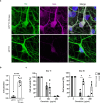This is a preprint.
Comparative study of enriched dopaminergic neurons from siblings with Gaucher disease discordant for parkinsonism
- PMID: 38529501
- PMCID: PMC10962709
- DOI: 10.1101/2024.02.25.581985
Comparative study of enriched dopaminergic neurons from siblings with Gaucher disease discordant for parkinsonism
Update in
-
Evaluation of Induced Pluripotent Stem Cell-Derived Dopaminergic Neurons from Siblings with Gaucher Disease Discordant for Parkinsonism.Mov Disord. 2025 Aug;40(8):1719-1724. doi: 10.1002/mds.30273. Epub 2025 Jun 26. Mov Disord. 2025. PMID: 40568761 Free PMC article.
Abstract
Inducible pluripotent stem cells (iPSCs) derived from patient samples have significantly enhanced our ability to model neurological diseases. Comparative studies of dopaminergic (DA) neurons differentiated from iPSCs derived from siblings with Gaucher disease discordant for parkinsonism provides a valuable avenue to explore genetic modifiers contributing to GBA1-associated parkinsonism in disease-relevant cells. However, such studies are often complicated by the inherent heterogeneity in differentiation efficiency among iPSC lines derived from different individuals. To address this technical challenge, we devised a selection strategy to enrich dopaminergic (DA) neurons expressing tyrosine hydroxylase (TH). A neomycin resistance gene (neo) was inserted at the C-terminus of the TH gene following a T2A self-cleavage peptide, placing its expression under the control of the TH promoter. This allows for TH+ DA neuron enrichment through geneticin selection. This method enabled us to generate comparable, high-purity DA neuron cultures from iPSC lines derived from three sisters that we followed for over a decade: one sibling is a healthy individual, and the other two have Gaucher disease (GD) with GBA1 genotype N370S/c.203delC+R257X (p.N409S/c.203delC+p.R296X). Notably, the younger sister with GD later developed Parkinson disease (PD). A comprehensive analysis of these high-purity DA neurons revealed that although GD DA neurons exhibited decreased levels of glucocerebrosidase (GCase), there was no substantial difference in GCase protein levels or lipid substrate accumulation between DA neurons from the GD and GD/PD sisters, suggesting that the PD discordance is related to of other genetic modifiers.
Keywords: GBA1; Gaucher disease; Parkinson disease; dopaminergic neuron differentiation; iPSC; neomycin resistance; neurodegeneration.
Figures






References
Publication types
LinkOut - more resources
Full Text Sources
